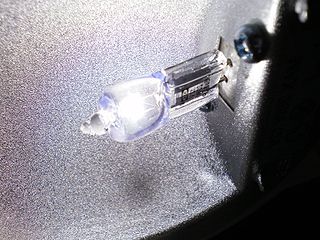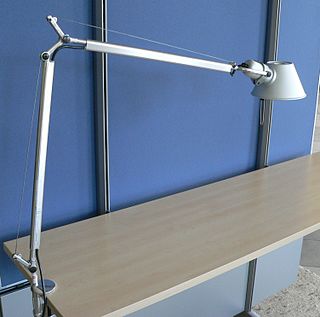
An incandescent light bulb, incandescent lamp or incandescent light globe is an electric light with a wire filament heated until it glows. The filament is enclosed in a glass bulb with a vacuum or inert gas to protect the filament from oxidation. Current is supplied to the filament by terminals or wires embedded in the glass. A bulb socket provides mechanical support and electrical connections.

A halogen lamp is an incandescent lamp consisting of a tungsten filament sealed in a compact transparent envelope that is filled with a mixture of an inert gas and a small amount of a halogen, such as iodine or bromine. The combination of the halogen gas and the tungsten filament produces a halogen-cycle chemical reaction, which redeposits evaporated tungsten on the filament, increasing its life and maintaining the clarity of the envelope. This allows the filament to operate at a higher temperature than a standard incandescent lamp of similar power and operating life; this also produces light with higher luminous efficacy and color temperature. The small size of halogen lamps permits their use in compact optical systems for projectors and illumination. The small glass envelope may be enclosed in a much larger outer glass bulb, which has a lower temperature, protects the inner bulb from contamination, and makes the bulb mechanically more similar to a conventional lamp.
An antifuse is an electrical device that performs the opposite function to a fuse. Whereas a fuse starts with a low resistance and is designed to permanently break an electrically conductive path, an antifuse starts with a high resistance, and programming it converts it into a permanent electrically conductive path. This technology has many applications.

The Tolomeo incandescent desk lamp is an icon of Italian modern design. It was designed by Michele De Lucchi and Giancarlo Fassina in 1986 for the Artemide company. It won the Compasso d'Oro design prize in 1989.

The sulfur lamp is a highly efficient full-spectrum electrodeless lighting system whose light is generated by sulfur plasma that has been excited by microwave radiation. They are a particular type of plasma lamp, and one of the most modern. The technology was developed in the early 1990s, but, although it appeared initially to be very promising, sulfur lighting was a commercial failure by the late 1990s. Since 2005, lamps are again being manufactured for commercial use.

A light fixture, light fitting, or luminaire is an electrical device containing an electric lamp that provides illumination. All light fixtures have a fixture body and one or more lamps. The lamps may be in sockets for easy replacement—or, in the case of some LED fixtures, hard-wired in place.

A parabolic aluminized reflector lamp is a type of electric lamp that is widely used in commercial, residential, and transportation illumination. It produces a highly directional beam. Usage includes theatrical lighting, locomotive headlamps, aircraft landing lights, and residential and commercial recessed lights.

Brionvega is an Italian electronics company that is known for manufacturing futuristic televisions and audio equipment. The company was founded in 1939 by Giuseppe Brion and Leone Pajettain in Milan. Initially named B.P.M. Radio, the company was rebranded as "BRIONVEGA" in 1963.

Edison screw (ES) is a standard lightbulb socket for electric light bulbs. It was developed by Thomas Edison (1847–1931), patented in 1881, and was licensed in 1909 under General Electric's Mazda trademark. The bulbs have right-hand threaded metal bases (caps) which screw into matching threaded sockets. For bulbs powered by AC current, the thread is generally connected to neutral and the contact on the bottom tip of the base is connected to the "live" phase.

Neil Poulton is a Scottish product designer, based in Paris, France. He specialises in the design of 'deceptively simple-looking mass-produced objects' and has won numerous international design awards. Poulton is best known for his designs in the fields of technology and lighting design and is often associated with manufacturers LaCie and Artemide.

Artemide is a design-oriented Italian manufacturer founded by Ernesto Gismondi and Sergio Mazza in 1960. Based in Pregnana Milanese, a suburb of Milan, the company specialises in the manufacture of lighting designed by designers and architects.

Richard Sapper was a German industrial designer based in Milan, Italy. He is considered one of the most important designers of his generation, his products typically featuring a combination of technical innovation, simplicity of form and an element of wit and surprise. He received numerous international design awards, including 11 Compasso d'Oro awards and the Raymond Loewy Foundation's Lucky Strike Designer Award. His designs are held in many museum collections around the world including the Victoria and Albert (V&A) and Design Museum in London, the Pompidou Center in Paris, the ADI Design Museum in Milan, and the Museum of Modern Art (MoMA) in New York, which holds over 17 of Sapper's products.

A multifaceted reflector light bulb is a reflector housing format for halogen as well as some LED and fluorescent lamps. MR lamps were originally designed for use in slide projectors, but see use in residential lighting and retail lighting as well. They are suited to applications that require directional lighting such as track lighting, recessed ceiling lights, desk lamps, pendant fixtures, landscape lighting, retail display lighting, and bicycle headlights. MR lamps are designated by symbols such as MR16 where the diameter is represented by numerals indicating units of eighths of an inch. Common sizes for general lighting are MR16 and MR11, with MR20 and MR8 used in specialty applications. Many run on low voltage rather than mains voltage alternating current so require a power supply.
Holiday lighting technology has been subject to considerable development and variation since the replacement of candles by electric lights. While originally used during the Christmas holidays as Christmas lights, modern electric light arrays have become popular around the world in many cultures and are used both during religious festivals and for other purposes unconnected to any festivities.

Ronald John Rezek is a design entrepreneur who started five successful companies and has designed hundreds of contemporary light fixtures and ceiling fans. He is an expert on design patents and copyrights, and is often used as an expert witness in court.
A lightbulb socket, lightbulb holder,light socket, lamp socket or lamp holder is a device which mechanically supports and provides electrical connections for a compatible electric lamp base. Sockets allow lamps to be safely and conveniently replaced (re-lamping). There are many different standards for lampholders, including early de facto standards and later standards created by various standards bodies. Many of the later standards conform to a general coding system in which a socket type is designated by a letter or abbreviation followed by a number.
The Giso 404 is a metal piano lamp designed in 1927 by Jacobus Johannes Pieter Oud, manufactured by the Dutch Gispen firm.

Michele de Lucchi is an Italian architect and designer.

A Tensor lamp is a trademarked brand of small high-intensity low-voltage desk lamp invented by Jay Monroe. The lamp was mainly popular during the 1960s and 1970s. The lamp was originally used by doctors and dentists, and later became more widely used. Although the first prototype was created in 1959, the lamp was not made available to public until 1960. The brand was manufactured by the Tensor Corporation.
The Lampette was a brand of small electric high-intensity telescoping desk lamps that was designed and distributed by Koch Creations but manufactured by various subcontractors from the early 1960s to the late 1980s.















